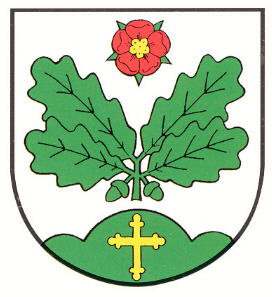Schönwalde am Bungsberg: Difference between revisions
Knorrepoes (talk | contribs) No edit summary |
Knorrepoes (talk | contribs) |
||
| Line 19: | Line 19: | ||
The arms were granted on February 11, 1986. | The arms were granted on February 11, 1986. | ||
The arms are partly canting, showing some oak leaves for the Wald-part of the name (Wald means forest). The rose symbolises beauty, and thus is canting fro Schön (= | The arms are partly canting, showing some oak leaves for the Wald-part of the name (Wald means forest). The rose symbolises beauty, and thus is canting fro Schön (=beautiful). The mountain in the base is the Bungsberg hill near the village. The cross symbolises that Schönwalde was founded in the 12<sup>th</sup> century by monks from the Cismar Abbey and has had its own church ever since. The four leaves represent the fact that the municipality was created in 1938 from Schönwalde, the Mönchneversdorf Estate and the villages Langenhagen and Hobstin. | ||
[[Literature]] : Reissmann, 1997 | [[Literature]] : Reissmann, 1997 | ||
Revision as of 13:50, 1 February 2014
| Heraldry of the World Civic heraldry of Germany - Deutsche Wappen (Gemeindewappen/Kreiswappen) |
SCHÖNWALDE AM BUNGSBERG
State : Schleswig-Holstein
District (Kreis) : Ostholstein (until 1970 Oldenburg in Holstein)
Amt : Amt Ostholstein-Mitte (until 2005 Amt Schönwalde)
Official blazon
Über grünem, mit einem goldenen Kleeblattkreuz belegtem Dreiberg in Silber ein grüner, aus vier Blättern und zwei Früchten symmetrisch angeordneter Eichenzweig, dessen obere Blätter eine rote Rose mit goldenem Butzen und grünen Kelchblättern einschließen.
Origin/meaning
The arms were granted on February 11, 1986.
The arms are partly canting, showing some oak leaves for the Wald-part of the name (Wald means forest). The rose symbolises beauty, and thus is canting fro Schön (=beautiful). The mountain in the base is the Bungsberg hill near the village. The cross symbolises that Schönwalde was founded in the 12th century by monks from the Cismar Abbey and has had its own church ever since. The four leaves represent the fact that the municipality was created in 1938 from Schönwalde, the Mönchneversdorf Estate and the villages Langenhagen and Hobstin.
Literature : Reissmann, 1997

